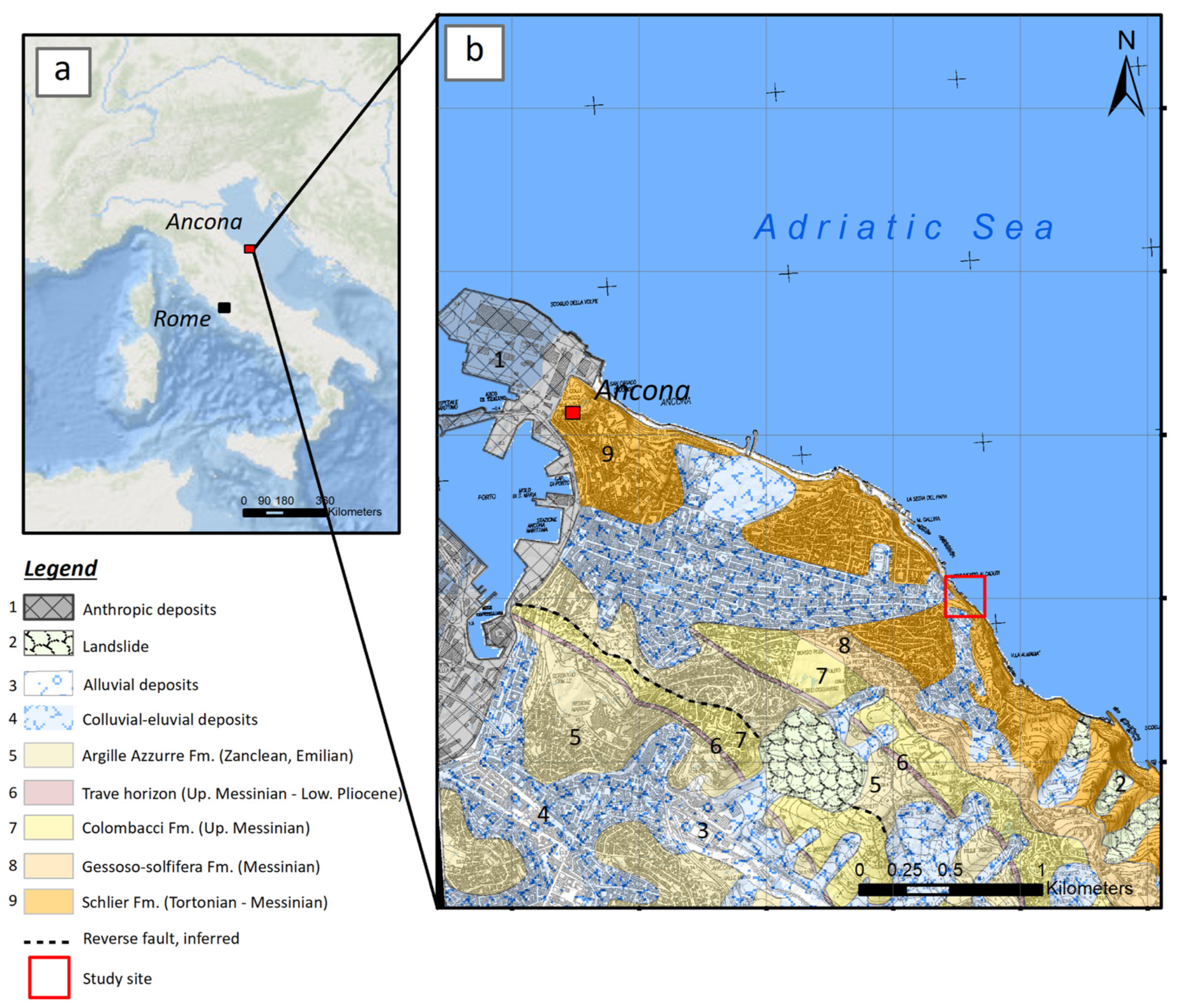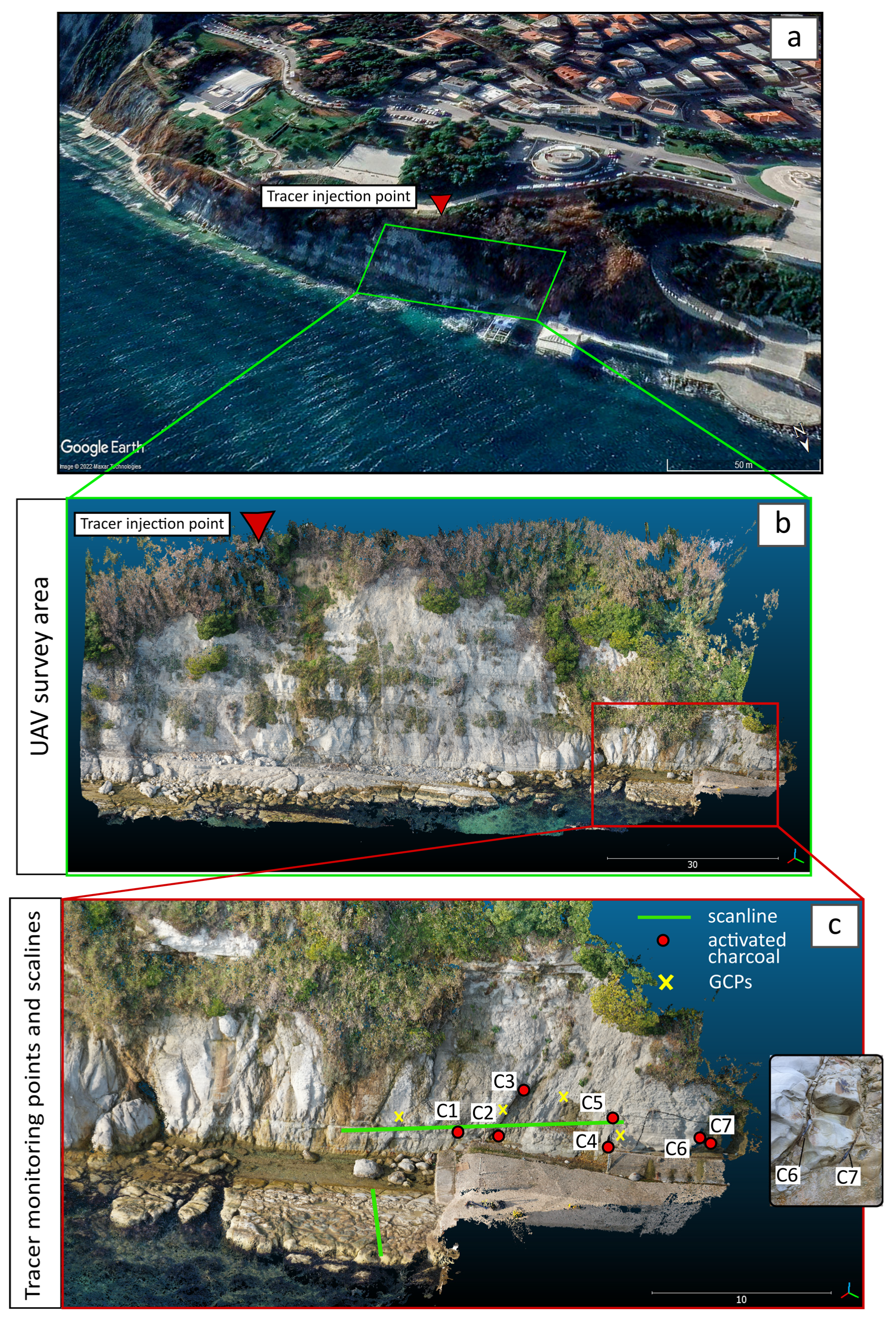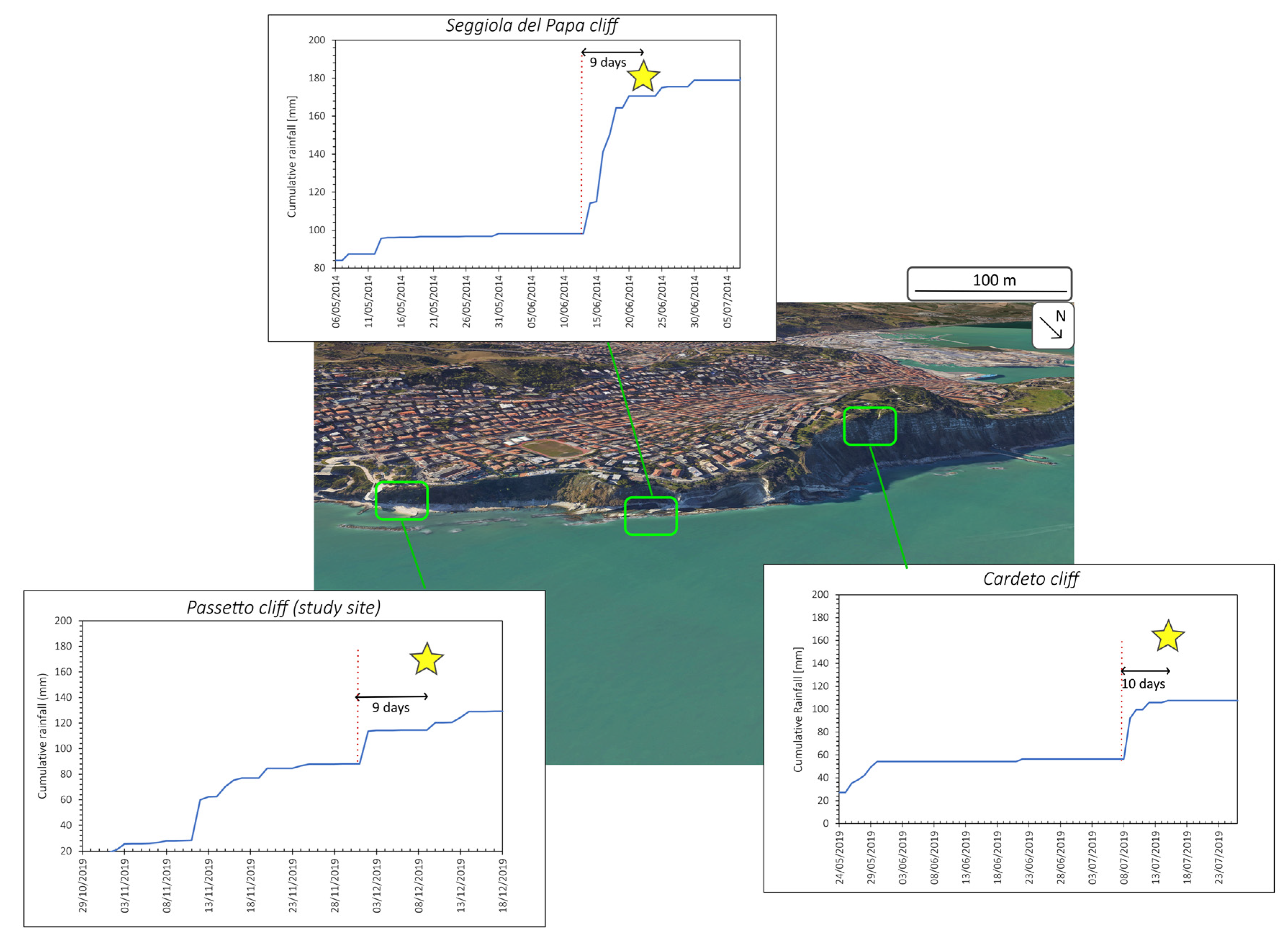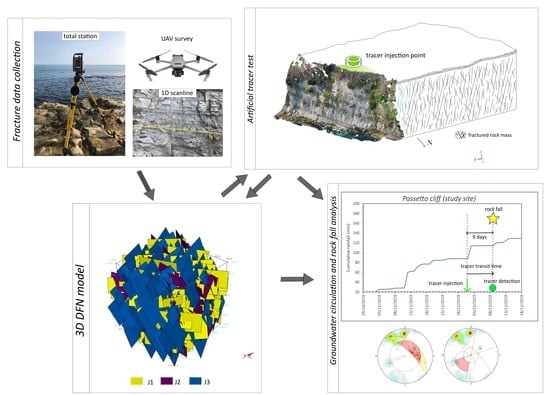3D Discrete Fracture Network Modelling from UAV Imagery Coupled with Tracer Tests to Assess Fracture Conductivity in an Unstable Rock Slope: Implications for Rockfall Phenomena
Abstract
1. Introduction
2. Geological and Geomechanical Outlines of the Study Site
3. Materials and Methods
3.1. Conventional and UAV-Based Geomechanical Survey
3.2. Fracture Analysis, 3D DFN Modelling and Cliff Kinematic Assessment
3.3. Hydrological Investigation
4. Results
4.1. Fracture Analysis
4.2. Rock Slope Hydrodynamic Features Achieved from Tracer Test
5. Discussion
6. Conclusions
Author Contributions
Funding
Data Availability Statement
Acknowledgments
Conflicts of Interest
References
- Karra, S.; O’Malley, D.; Hyman, J.D.; Viswanathan, H.S.; Srinivasan, G. Modeling Flow and Transport in Fracture Networks Using Graphs. Phys. Rev. E 2018, 97, 033304. [Google Scholar] [CrossRef] [PubMed]
- Berkowitz, B. Characterizing Flow and Transport in Fractured Geological Media: A Review. Adv. Water Resour. 2002, 25, 861–884. [Google Scholar] [CrossRef]
- Adler, P.M.; Thovert, J.-F.; Mourzenko, V.V. Fractured Porous Media; Oxford University Press: Oxford, UK, 2013; ISBN 0-19-966651-2. [Google Scholar]
- Worthington, S.R. Estimating Effective Porosity in Bedrock Aquifers. Groundwater 2022, 60, 169–179. [Google Scholar] [CrossRef]
- Krzeminska, D.M.; Bogaard, T.A.; Van Asch, T.W.; Van Beek, L.P.H. A Conceptual Model of the Hydrological Influence of Fissures on Landslide Activity. Hydrol. Earth Syst. Sci. 2012, 16, 1561–1576. [Google Scholar] [CrossRef]
- Krzeminska, D.M.; Bogaard, T.A.; Malet, J.-P.; Van Beek, L.P.H. A Model of Hydrological and Mechanical Feedbacks of Preferential Fissure Flow in a Slow-Moving Landslide. Hydrol. Earth Syst. Sci. 2013, 17, 947–959. [Google Scholar] [CrossRef]
- Camanni, G.; Vinci, F.; Tavani, S.; Ferrandino, V.; Mazzoli, S.; Corradetti, A.; Parente, M.; Iannace, A. Fracture Density Variations within a Reservoir-Scale Normal Fault Zone: A Case Study from Shallow-Water Carbonates of Southern Italy. J. Struct. Geol. 2021, 151, 104432. [Google Scholar] [CrossRef]
- Mayolle, S.; Soliva, R.; Dominguez, S.; Wibberley, C.; Caniven, Y. Nonlinear Fault Damage Zone Scaling Revealed through Analog Modeling. Geology 2021, 49, 968–972. [Google Scholar] [CrossRef]
- Price, J. Implications of Groundwater Behaviour on the Geomechanics of Rock Slope Stability. In Proceedings of the APSSIM 2016: Proceedings of the First Asia Pacific Slope Stability in Mining Conference, Brisbane, WLS, Australia, 4–6 September 2016; pp. 25–48. [Google Scholar]
- Vasarhelyi, B.; Ván, P.J.E.G. Influence of water content on the strength of rock. Eng. Geol. 2006, 84, 70–74. [Google Scholar] [CrossRef]
- Althaus, E.; Friz-Töpfer, A.; Lempp, C.; Natau, O. Effects of Water on Strength and Failure Mode of Coarse-Grained Granites at 300 C. Rock Mech. Rock Eng. 1994, 27, 1–21. [Google Scholar] [CrossRef]
- Pan, Y.; Wu, G.; Zhao, Z.; He, L. Analysis of Rock Slope Stability under Rainfall Conditions Considering the Water-Induced Weakening of Rock. Comput. Geotech. 2020, 128, 103806. [Google Scholar] [CrossRef]
- Neuman, S.P. Trends, Prospects and Challenges in Quantifying Flow and Transport through Fractured Rocks. Hydrogeol. J. 2005, 13, 124–147. [Google Scholar] [CrossRef]
- Wei, M.; Dai, F.; Ji, Y.; Wu, W. Effect of Fluid Pressure Gradient on the Factor of Safety in Rock Stability Analysis. Eng. Geol. 2021, 294, 106346. [Google Scholar] [CrossRef]
- International Society for Rock Mechanics Commission on Standardization of Laboratory and Field Tests. Suggested Methods for the Quantitative Description of Discontinuities in Rock Masses. Int. J. Rock Mech. Min. Sci. Geomech. Abstr. 1978, 15, 319–368. [Google Scholar] [CrossRef]
- Volatili, T.; Agosta, F.; Cardozo, N.; Zambrano, M.; Lecomte, I.; Tondi, E. Outcrop-Scale Fracture Analysis and Seismic Modelling of a Basin-Bounding Normal Fault in Platform Carbonates, Central Italy. J. Struct. Geol. 2022, 155, 104515. [Google Scholar] [CrossRef]
- Jia, L.; Cai, J.; Wu, L.; Qin, T.; Song, K. Influence of Fracture Geometric Characteristics on Fractured Rock Slope Stability. Appl. Sci. 2023, 13, 236. [Google Scholar] [CrossRef]
- Daniela, R.; Ermanno, M.; Antonio, P.; Pasquale, R.; Marco, V. Assessment of Tuff Sea Cliff Stability Integrating Geological Surveys and Remote Sensing. Case History from Ventotene Island (Southern Italy). Remote Sens. 2020, 12, 2006. [Google Scholar] [CrossRef]
- Leucci, G.; Persico, R.; De Giorgi, L.; Lazzari, M.; Colica, E.; Martino, S.; Iannucci, R.; Galone, L.; D’Amico, S. Stability Assessment and Geomorphological Evolution of Sea Natural Arches by Geophysical Measurement: The Case Study of Wied Il-Mielah Window (Gozo, Malta). Sustainability 2021, 13, 12538. [Google Scholar] [CrossRef]
- Kemeny, J.; Post, R. Estimating Three-Dimensional Rock Discontinuity Orientation from Digital Images of Fracture Traces. Comput. Geosci. 2003, 29, 65–77. [Google Scholar] [CrossRef]
- Feng, Q.H.; Röshoff, K. In-Situ Mapping and Documentation of Rock Faces Using a Full-Coverage 3d Laser Scanning Technique. Int. J. Rock Mech. Min. Sci. 2004, 41, 139–144. [Google Scholar] [CrossRef]
- Pringle, J.K.; Westerman, R.; Gardiner, A.R. Virtual Geological Outcrops-Fieldwork and Analysis Made Less Exhaustive? Geol. Today 2004, 20, 64–69. [Google Scholar] [CrossRef]
- Mammoliti, E.; Stefano, F.D.; Fronzi, D.; Mancini, A.; Malinverni, E.S.; Tazioli, A. A Machine Learning Approach to Extract Rock Mass Discontinuity Orientation and Spacing, from Laser Scanner Point Clouds. Remote Sens. 2022, 14, 2365. [Google Scholar] [CrossRef]
- Gigli, G.; Casagli, N. Semi-Automatic Extraction of Rock Mass Structural Data from High Resolution LIDAR Point Clouds. Int. J. Rock Mech. Min. Sci. 2011, 48, 187–198. [Google Scholar] [CrossRef]
- Lato, M.; Diederichs, M.S.; Hutchinson, D.J.; Harrap, R. Optimization of LiDAR Scanning and Processing for Automated Structural Evaluation of Discontinuities in Rockmasses. Int. J. Rock Mech. Min. Sci. 2009, 46, 194–199. [Google Scholar] [CrossRef]
- Gigli, G.; Morelli, S.; Fornera, S.; Casagli, N. Terrestrial Laser Scanner and Geomechanical Surveys for the Rapid Evaluation of Rock Fall Susceptibility Scenarios. Landslides 2014, 11, 1–14. [Google Scholar] [CrossRef]
- Riquelme, A.J.; Abellán, A.; Tomás, R. Discontinuity Spacing Analysis in Rock Masses Using 3D Point Clouds. Eng. Geol. 2015, 195, 185–195. [Google Scholar] [CrossRef]
- Gigli, G.; Frodella, W.; Garfagnoli, F.; Morelli, S.; Mugnai, F.; Menna, F.; Casagli, N. 3-D Geomechanical Rock Mass Characterization for the Evaluation of Rockslide Susceptibility Scenarios. Landslides 2014, 11, 131–140. [Google Scholar] [CrossRef]
- Nyberg, B.; Nixon, C.W.; Sanderson, D.J. NetworkGT: A GIS Tool for Geometric and Topological Analysis of Two-Dimensional Fracture Networks. Geosphere 2018, 14, 1618–1634. [Google Scholar] [CrossRef]
- Laux, D.; Henk, A. Terrestrial Laser Scanning and Fracture Network Characterisation–Perspectives for a (Semi-) Automatic Analysis of Point Cloud Data from Outcrops. Z. Dtsch. Ges. Für Geowiss. 2015, 166, 99–118. [Google Scholar] [CrossRef]
- Massaro, L.; Corradetti, A.; Vinci, F.; Tavani, S.; Iannace, A.; Parente, M.; Mazzoli, S. Multiscale Fracture Analysis in a Reservoir-Scale Carbonate Platform Exposure (Sorrento Peninsula, Italy): Implications for Fluid Flow. Geofluids 2018, 2018, 7526425. [Google Scholar] [CrossRef]
- Loiotine, L.; Liso, I.S.; Parise, M.; Andriani, G.F. Optimization of Geostructural Surveys in Rock Mass Stability Analyses Using Remote Sensing Techniques. Ital. J. Eng. Geol. Environ. 2019, 73–78. [Google Scholar] [CrossRef]
- Walter, C.; Faraj, F.; Fotopoulos, G.; Braun, A. Augmenting Geological Field Mapping with Real-Time, 3-D Digital Outcrop Scanning and Modeling. Geosphere 2022, 18, 762–779. [Google Scholar] [CrossRef]
- Sturzenegger, M.; Stead, D. Close-Range Terrestrial Digital Photogrammetry and Terrestrial Laser Scanning for Discontinuity Characterization on Rock Cuts. Eng. Geol. 2009, 106, 163–182. [Google Scholar] [CrossRef]
- Jablonska, D.; Pitts, A.; Di Celma, C.; Volatili, T.; Alsop, G.I.; Tondi, E. 3D Outcrop Modelling of Large Discordant Breccia Bodies in Basinal Carbonates of the Apulian Margin, Italy. Mar. Pet. Geol. 2021, 123, 104732. [Google Scholar] [CrossRef]
- Schilirò, L.; Robiati, C.; Smeraglia, L.; Vinci, F.; Iannace, A.; Parente, M.; Tavani, S. An Integrated Approach for the Reconstruction of Rockfall Scenarios from UAV and Satellite-Based Data in the Sorrento Peninsula (Southern Italy). Eng. Geol. 2022, 308, 106795. [Google Scholar] [CrossRef]
- Pitts, A.D.; Casciano, C.I.; Patacci, M.; Longhitano, S.G.; Di Celma, C.; McCaffrey, W.D. Integrating Traditional Field Methods with Emerging Digital Techniques for Enhanced Outcrop Analysis of Deep Water Channel-Fill Deposits. Mar. Pet. Geol. 2017, 87, 2–13. [Google Scholar] [CrossRef]
- Smeraglia, L.; Mercuri, M.; Tavani, S.; Pignalosa, A.; Kettermann, M.; Billi, A.; Carminati, E. 3D Discrete Fracture Network (DFN) Models of Damage Zone Fluid Corridors within a Reservoir-Scale Normal Fault in Carbonates: Multiscale Approach Using Field Data and UAV Imagery. Mar. Pet. Geol. 2021, 126, 104902. [Google Scholar] [CrossRef]
- Giuffrida, A.; La Bruna, V.; Castelluccio, P.; Panza, E.; Rustichelli, A.; Tondi, E.; Giorgioni, M.; Agosta, F. Fracture Simulation Parameters of Fractured Reservoirs: Analogy with Outcropping Carbonates of the Inner Apulian Platform, Southern Italy. J. Struct. Geol. 2019, 123, 18–41. [Google Scholar] [CrossRef]
- Seers, T.D.; Sheharyar, A.; Tavani, S.; Corradetti, A. Virtual Outcrop Geology Comes of Age: The Application of Consumer-Grade Virtual Reality Hardware and Software to Digital Outcrop Data Analysis. Comput. Geosci. 2022, 159, 105006. [Google Scholar] [CrossRef]
- Corradetti, A.; Tavani, S.; Parente, M.; Iannace, A.; Vinci, F.; Pirmez, C.; Torrieri, S.; Giorgioni, M.; Pignalosa, A.; Mazzoli, S. Distribution and Arrest of Vertical Through-Going Joints in a Seismic-Scale Carbonate Platform Exposure (Sorrento Peninsula, Italy): Insights from Integrating Field Survey and Digital Outcrop Model. J. Struct. Geol. 2018, 108, 121–136. [Google Scholar] [CrossRef]
- Lei, Q.; Latham, J.-P.; Tsang, C.-F. The Use of Discrete Fracture Networks for Modelling Coupled Geomechanical and Hydrological Behaviour of Fractured Rocks. Comput. Geotech. 2017, 85, 151–176. [Google Scholar] [CrossRef]
- Makedonska, N.; Jafarov, E.; Doe, T.; Schwering, P.; Neupane, G. EGS Collab Team Simulation of Injected Flow Pathways in Geothermal Fractured Reservoir Using Discrete Fracture Network Model. In Proceedings of the 45th Workshop on Geothermal Reservoir Engineering, Stanford, CA, USA, 10–12 February 2020; pp. 10–12. [Google Scholar]
- Zhang, Q.-H.; Yin, J.-M. Solution of Two Key Issues in Arbitrary Three-Dimensional Discrete Fracture Network Flow Models. J. Hydrol. 2014, 514, 281–296. [Google Scholar] [CrossRef]
- Volatili, T.; Zambrano, M.; Cilona, A.; Huisman, B.A.H.; Rustichelli, A.; Giorgioni, M.; Vittori, S.; Tondi, E. From Fracture Analysis to Flow Simulations in Fractured Carbonates: The Case Study of the Roman Valley Quarry (Majella Mountain, Italy). Mar. Pet. Geol. 2019, 100, 95–110. [Google Scholar] [CrossRef]
- Romano, V.; Bigi, S.; Carnevale, F.; Hyman, J.D.; Karra, S.; Valocchi, A.J.; Tartarello, M.C.; Battaglia, M. Hydraulic Characterization of a Fault Zone from Fracture Distribution. J. Struct. Geol. 2020, 135, 104036. [Google Scholar] [CrossRef]
- Panza, E.; Sessa, E.; Agosta, F.; Giorgioni, M. Discrete Fracture Network Modelling of a Hydrocarbon-Bearing, Oblique-Slip Fault Zone: Inferences on Fault-Controlled Fluid Storage and Migration Properties of Carbonate Fault Damage Zones. Mar. Pet. Geol. 2018, 89, 263–279. [Google Scholar] [CrossRef]
- Giuffrida, A.; Agosta, F.; Rustichelli, A.; Panza, E.; La Bruna, V.; Eriksson, M.; Torrieri, S.; Giorgioni, M. Fracture Stratigraphy and DFN Modelling of Tight Carbonates, the Case Study of the Lower Cretaceous Carbonates Exposed at the Monte Alpi (Basilicata, Italy). Mar. Pet. Geol. 2020, 112, 104045. [Google Scholar] [CrossRef]
- Li, X.; Liu, J.; Gong, W.; Xu, Y.; Bowa, V.M. A Discrete Fracture Network Based Modeling Scheme for Analyzing the Stability of Highly Fractured Rock Slope. Comput. Geotech. 2022, 141, 104558. [Google Scholar] [CrossRef]
- Hamm, S.-Y.; Kim, M.; Cheong, J.-Y.; Kim, J.-Y.; Son, M.; Kim, T.-W. Relationship between Hydraulic Conductivity and Fracture Properties Estimated from Packer Tests and Borehole Data in a Fractured Granite. Eng. Geol. 2007, 92, 73–87. [Google Scholar] [CrossRef]
- Chen, G.; Illman, W.A.; Thompson, D.L.; Vesselinov, V.V.; Neuman, S.P. Geostatistical, Type-Curve, and Inverse Analyses of Pneumatic Injection Tests in Unsaturated Fractured Tuffs at the Apache Leap Research Site near Superior, Arizona. In Dynamics of Fluids in Fractured Rock; Blackwell Publishing Ltd.: Ofxord, UK, 2000; pp. 73–98. [Google Scholar]
- Fronzi, D.; Mirabella, F.; Cardellini, C.; Caliro, S.; Palpacelli, S.; Cambi, C.; Valigi, D.; Tazioli, A. The Role of Faults in Groundwater Circulation before and after Seismic Events: Insights from Tracers, Water Isotopes and Geochemistry. Water 2021, 13, 1499. [Google Scholar] [CrossRef]
- Fronzi, D.; Di Curzio, D.; Rusi, S.; Valigi, D.; Tazioli, A. Comparison between Periodic Tracer Tests and Time-Series Analysis to Assess Mid- and Long-Term Recharge Model Changes Due to Multiple Strong Seismic Events in Carbonate Aquifers. Water 2020, 12, 3073. [Google Scholar] [CrossRef]
- Mammoliti, E.; Fronzi, D.; Cambi, C.; Mirabella, F.; Cardellini, C.; Patacchiola, E.; Tazioli, A.; Caliro, S.; Valigi, D. A Holistic Approach to Study Groundwater-Surface Water Modifications Induced by Strong Earthquakes: The Case of Campiano Catchment (Central Italy). Hydrology 2022, 9, 97. [Google Scholar] [CrossRef]
- Iadanza, C.; Trigila, A.; Vittori, E.; Serva, L. Landslides in Coastal Areas of Italy. Geol. Soc. Lond. Spec. Publ. 2009, 322, 121–141. [Google Scholar] [CrossRef]
- Fruzzetti, V.M.E.; Segato, D.; Ruggeri, P.; Vita, A.; Sakellariadi, E.; Scarpelli, G. Fenomeni di Instabilità Della Falesia del Monte Conero: Ruolo Dell’assetto Strutturale. In Proceedings of the Incontro Annuale dei Ricercatori di Geotecnica 2011—IARG 2011, Torino, Italy, 4–6 July 2011; pp. 1–6. [Google Scholar]
- Pierantoni, P.; Deiana, G.; Galdenzi, S. Stratigraphic and Structural Features of the Sibillini Mountains (Umbria-Marche Apennines, Italy). Ital. J. Geosci. 2013, 132, 497–520. [Google Scholar] [CrossRef]
- Casagli, N.; Garzonio, C.A.; Nanni, T. Geomechanical Characterization and Slope Instability of the Marly Sea Cliffs of Ancona, Italy. In Proceedings of the Geotechnical Engineering of Hard Soils-Soft Rocks, Athens, Greece, 20–23 September 1993; pp. 1093–1100. [Google Scholar]
- Fronzi, D.; Gaiolini, M.; Mammoliti, E.; Colombani, N.; Palpacelli, S.; Marcellini, M.; Tazioli, A. Groundwater-Surface Water Interaction Revealed by Meteorological Trends and Groundwater Fluctuations on Stream Water Level. Acque Sotter. Ital. J. Groundw. 2022, 11, 19–28. [Google Scholar] [CrossRef]
- Barton, N.; Choubey, V. The Shear Strength of Rock Joints in Theory and Practice. Rock Mech. 1977, 10, 1–54. [Google Scholar] [CrossRef]
- Ortega, O.J.; Marrett, R.A.; Laubach, S.E. A Scale-Independent Approach to Fracture Intensity and Average Spacing Measurement. AAPG Bull. 2006, 90, 193–208. [Google Scholar] [CrossRef]
- Terzaghi, R.D. Sources of Error in Joint Surveys. Geotechnique 1965, 15, 287–304. [Google Scholar] [CrossRef]
- Fisher, R.A. Dispersion on a Sphere. Proc. R. Soc. Lond. Ser. Math. Phys. Sci. 1953, 217, 295–305. [Google Scholar] [CrossRef]
- Rocscience. DIPS. 2018. Available online: http://www.rocscience.com (accessed on 11 May 2018).
- Dershowitz, W.S.; Herda, H.H. Interpretation of Fracture Spacing and Intensity. In Proceedings of the 33rd US Symposium on Rock Mechanics (USRMS), Santa Fe, NM, USA, 8–10 June 1992. [Google Scholar]
- Sanderson, D.J.; Nixon, C.W. Topology, Connectivity and Percolation in Fracture Networks. J. Struct. Geol. 2018, 115, 167–177. [Google Scholar] [CrossRef]
- Petroleum Experts. Move. 2019. Available online: https://www.petex.com/ (accessed on 2 August 2022).
- Wenli, Y.; Sharifzadeh, M.; Yang, Z.; Xu, G.; Fang, Z. Assessment of Fracture Characteristics Controlling Fluid Flow Performance in Discrete Fracture Networks (DFN). J. Pet. Sci. Eng. 2019, 178, 1104–1111. [Google Scholar] [CrossRef]
- Cowie, P.A.; Scholz, C.H. Displacement-Length Scaling Relationship for Faults: Data Synthesis and Discussion. J. Struct. Geol. 1992, 14, 1149–1156. [Google Scholar] [CrossRef]
- Olson, J.E. Sublinear Scaling of Fracture Aperture versus Length: An Exception or the Rule? J. Geophys. Res. Solid Earth 2003, 108, 35. [Google Scholar] [CrossRef]
- Scholz, C.H. A Note on the Scaling Relations for Opening Mode Fractures in Rock. J. Struct. Geol. 2010, 32, 1485–1487. [Google Scholar] [CrossRef]
- Zambrano, M.; Pitts, A.D.; Salama, A.; Volatili, T.; Giorgioni, M.; Tondi, E. Analysis of Fracture Roughness Control on Permeability Using SfM and Fluid Flow Simulations: Implications for Carbonate Reservoir Characterization. Geofluids 2019, 2019, 4132386. [Google Scholar] [CrossRef]
- Chua, L.H.; Robertson, A.P.; Yee, W.K.; Shuy, E.B.; Lo, E.Y.; Lim, T.T.; Tan, S.K. Use of Fluorescein as a Ground Water Tracer in Brackish Water Aquifers. Groundwater 2007, 45, 85–88. [Google Scholar] [CrossRef]
- Sabatini, D.A.; Austin, T.A. Characteristics of Rhodamine WT and Fluorescein as Adsorbing Ground-water Tracers. Groundwater 1991, 29, 341–349. [Google Scholar] [CrossRef]
- Kasnavia, T.; Vu, D.; Sabatini, D.A. Fluorescent Dye and Media Properties Affecting Sorption and Tracer Selection. Groundwater 1999, 37, 376–381. [Google Scholar] [CrossRef]
- Sutton, D.J.; Kabala, Z.J.; Francisco, A.; Vasudevan, D. Limitations and Potential of Commercially Available Rhodamine WT as a Groundwater Tracer. Water Resour. Res. 2001, 37, 1641–1656. [Google Scholar] [CrossRef]
- Corbett, D.R.; Dillon, K.; Burnett, W. Tracing Groundwater Flow on a Barrier Island in the North-East Gulf of Mexico. Estuar. Coast. Shelf Sci. 2000, 51, 227–242. [Google Scholar] [CrossRef]
- Field, M.S.; Wilhelm, R.G.; Quinlan, J.F.; Aley, T.J. An Assessment of the Potential Adverse Properties of Fluorescent Tracer Dyes Used for Groundwater Tracing. Environ. Monit. Assess. 1995, 38, 75–96. [Google Scholar] [CrossRef]
- James, M.R.; Chandler, J.H.; Eltner, A.; Fraser, C.; Miller, P.E.; Mills, J.P.; Noble, T.; Robson, S.; Lane, S.N. Guidelines on the Use of Structure-from-motion Photogrammetry in Geomorphic Research. Earth Surf. Process. Landf. 2019, 44, 2081–2084. [Google Scholar] [CrossRef]
- Philip, J.R. The Theory of Infiltration: 4. Sorptivity and Algebraic Infiltration Equations. Soil Sci. 1957, 84, 257–264. [Google Scholar] [CrossRef]
- He, L.; Coggan, J.; Francioni, M.; Eyre, M. Maximizing Impacts of Remote Sensing Surveys in Slope Stability—A Novel Method to Incorporate Discontinuities into Machine Learning Landslide Prediction. ISPRS Int. J. GeoInf. 2021, 10, 232. [Google Scholar] [CrossRef]
- Devoto, S.; Macovaz, V.; Mantovani, M.; Soldati, M.; Furlani, S. Advantages of Using UAV Digital Photogrammetry in the Study of Slow-Moving Coastal Landslides. Remote Sens. 2020, 12, 3566. [Google Scholar] [CrossRef]
- Francioni, M.; Antonaci, F.; Sciarra, N.; Robiati, C.; Coggan, J.; Stead, D.; Calamita, F. Application of Unmanned Aerial Vehicle Data and Discrete Fracture Network Models for Improved Rockfall Simulations. Remote Sens. 2020, 12, 2053. [Google Scholar] [CrossRef]
- Tuckey, Z. An Integrated UAV Photogrammetry-Discrete Element Investigation of Jointed Triassic Sandstone near Sydney, Australia. Eng. Geol. 2022, 297, 106517. [Google Scholar] [CrossRef]
- Berardinelli, D. Crollo al Passetto, Daniele Berardinelli (PdL): “Anni Di Promesse Ma Nessun Intervento”. 2014. Available online: https://www.anconatoday.it/politica/frana-passetto-ancona-daniele-berardinelli-forza-italia.html (accessed on 1 July 2022).
- Verdenelli, M. Ancona, Crolli Alla Spiaggia Della Grotta Azzurra. 2019. Available online: https://www.ilrestodelcarlino.it/ancona/cronaca/crolli-grotta-azzurra-1.4694097 (accessed on 1 July 2022).











| Total Station Measurement (m) | 3D Model (m) |
|---|---|
| 64.472 | 64.458 |
| Compass measurement of dip and dip direction (degrees) | 3D model-extracted dip and dip direction (degrees) |
| 65/67 | 60/68 |
| J1 | J2 | J3 | S0 | ||
|---|---|---|---|---|---|
| Dip angle/Dip direction (°) | 71/141 | 88/188 | 65/67 | 46/231 | |
| Fisher value | 25.9 | 14 | 81 | 867 | |
| Fracture trace length (m) | Min | 0.2 | 0.2 | 0.18 | n.d. |
| Mean | 1.82 | 1.60 | 2.22 | n.d. | |
| Max | 12.46 | 11.32 | 13.87 | n.d. | |
| Std Dev | 2.06 | 2.14 | 2.86 | n.d. | |
| Min | 0.18 | 0.12 | 0.18 | n.d. | |
| Hydraulic aperture (mm) | Mean | 0.24 | 0.19 | 0.25 | n.d. |
| Max | 0.95 | 0.5 | 0.5 | n.d. | |
| Min | 0.90 | 0.70 | 0.90 | n.d. | |
| Mechanical aperture (mm) | Mean | 0.95 | 0.85 | 1.00 | n.d. |
| Max | 2.60 | 1.80 | 1.80 | n.d. |
| J1 | J2 | J3 | S0 | |
|---|---|---|---|---|
| Mean P21 (sampling window 1, m/m2) | 0.96 | 0.74 | 1.89 | n.d. |
| Mean P21 of the DFN (m/m2) | 0.91 | 0.87 | 1.90 | n.d. |
| Fracture intensity P32 (m2/m3) | 0.8 | 0.5 | 1.8 | n.d. |
| Average K (cm/s) | ||
|---|---|---|
| DFN | fractures | 2.91 × 10−3 |
| Tracer test | fractures | 2.89 × 10−3 |
| topsoil | 1.8 × 10−2 * |
Disclaimer/Publisher’s Note: The statements, opinions and data contained in all publications are solely those of the individual author(s) and contributor(s) and not of MDPI and/or the editor(s). MDPI and/or the editor(s) disclaim responsibility for any injury to people or property resulting from any ideas, methods, instructions or products referred to in the content. |
© 2023 by the authors. Licensee MDPI, Basel, Switzerland. This article is an open access article distributed under the terms and conditions of the Creative Commons Attribution (CC BY) license (https://creativecommons.org/licenses/by/4.0/).
Share and Cite
Mammoliti, E.; Pepi, A.; Fronzi, D.; Morelli, S.; Volatili, T.; Tazioli, A.; Francioni, M. 3D Discrete Fracture Network Modelling from UAV Imagery Coupled with Tracer Tests to Assess Fracture Conductivity in an Unstable Rock Slope: Implications for Rockfall Phenomena. Remote Sens. 2023, 15, 1222. https://doi.org/10.3390/rs15051222
Mammoliti E, Pepi A, Fronzi D, Morelli S, Volatili T, Tazioli A, Francioni M. 3D Discrete Fracture Network Modelling from UAV Imagery Coupled with Tracer Tests to Assess Fracture Conductivity in an Unstable Rock Slope: Implications for Rockfall Phenomena. Remote Sensing. 2023; 15(5):1222. https://doi.org/10.3390/rs15051222
Chicago/Turabian StyleMammoliti, Elisa, Alessandro Pepi, Davide Fronzi, Stefano Morelli, Tiziano Volatili, Alberto Tazioli, and Mirko Francioni. 2023. "3D Discrete Fracture Network Modelling from UAV Imagery Coupled with Tracer Tests to Assess Fracture Conductivity in an Unstable Rock Slope: Implications for Rockfall Phenomena" Remote Sensing 15, no. 5: 1222. https://doi.org/10.3390/rs15051222
APA StyleMammoliti, E., Pepi, A., Fronzi, D., Morelli, S., Volatili, T., Tazioli, A., & Francioni, M. (2023). 3D Discrete Fracture Network Modelling from UAV Imagery Coupled with Tracer Tests to Assess Fracture Conductivity in an Unstable Rock Slope: Implications for Rockfall Phenomena. Remote Sensing, 15(5), 1222. https://doi.org/10.3390/rs15051222














